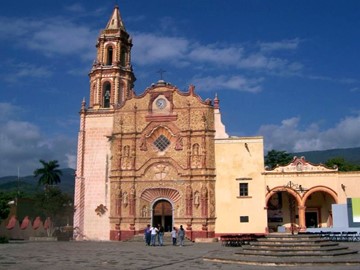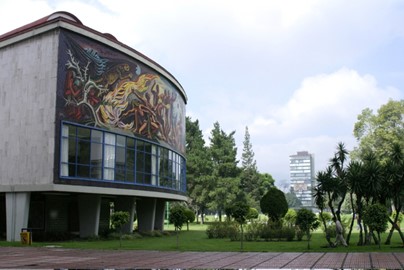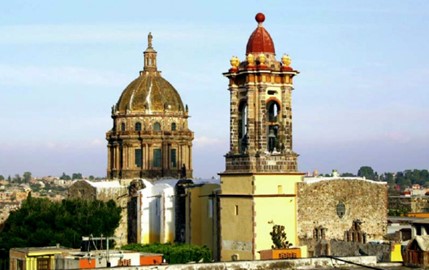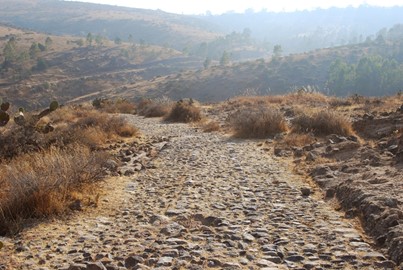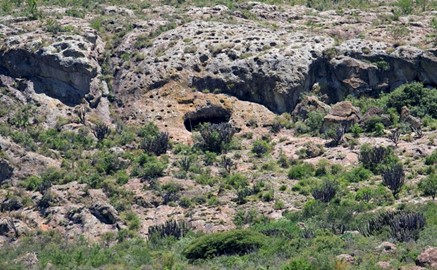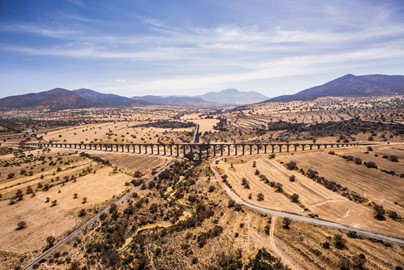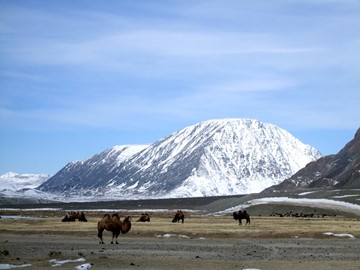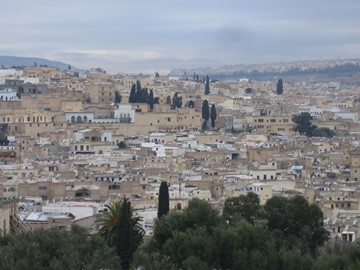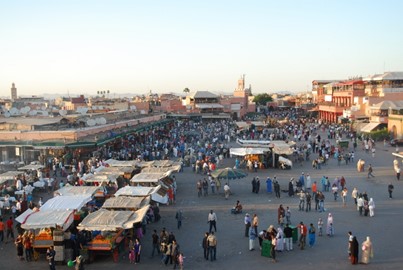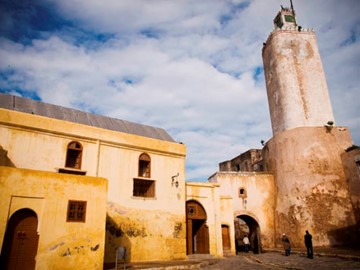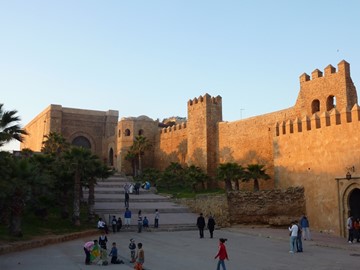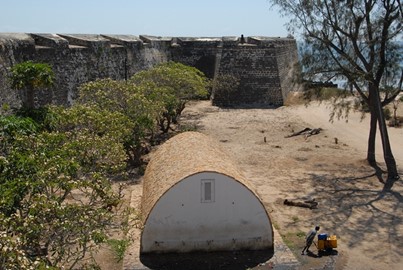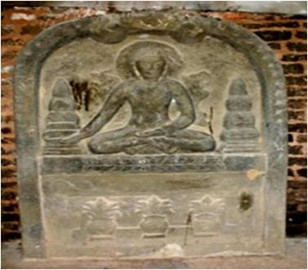category :: cultural
Xochicalco
Xochicalco, a UNESCO World Heritage site in Mexico, is a remarkably preserved pre-Columbian archaeological zone known for its intricate architecture and cultural significance. Flourishing between 650 and 900 CE, it served as a political, religious, and commercial hub, blending influences from Teotihuacan, Maya, and Zapotec civilizations. The site’s highlights include the Temple of the Feathered Serpent, adorned with detailed carvings, and an advanced underground observatory for tracking celestial events. It... Read More
Franciscan Missions in the Sierra Gorda
The Franciscan Missions in the Sierra Gorda, a UNESCO World Heritage site in Mexico, are a remarkable example of 18th-century colonial architecture and religious heritage. Built by Franciscan friars between 1750 and 1760, these five missions—featuring ornate facades and intricate Baroque designs—served to evangelize indigenous communities. Their historical significance and well-preserved condition highlight their role in shaping the region’s cultural landscape, earning them global recognition.
Luis Barragán House and Studio
The Luis Barragán House and Studio, a UNESCO World Heritage site in Mexico, is a masterful example of modern architecture designed by the renowned architect Luis Barragán between 1947 and 1948. This iconic residence showcases his innovative use of color, light, and space, blending traditional Mexican elements with minimalist design. Preserved as a museum, it offers insight into Barragán’s creative process and remains a testament to his lasting influence on global architecture.
Tequila
The Agave Landscape and Ancient Industrial Facilities of Tequila, a UNESCO World Heritage site in Mexico, showcase a unique blend of natural and cultural heritage in Mexico. This region features expansive blue agave fields, cultivated for centuries to produce tequila, alongside historic distilleries and haciendas that reflect traditional production methods. Recognized for its significance in shaping tequila’s global identity, the site highlights the interplay between agriculture, industry, and cultural trad... Read More
Central University City Campus
The Central University City Campus of the National Autonomous University of Mexico (UNAM), a UNESCO World Heritage site, is a remarkable example of 20th-century modernist architecture and urban planning. Designed by prominent Mexican architects and artists, including Mario Pani and Diego Rivera, the campus integrates functional buildings with vibrant murals and sculptures, reflecting Mexico’s cultural identity. Constructed in the 1950s, it serves as a hub for education and research while showcasing innovati... Read More
San Miguel and Jesús Nazareno
San Miguel and the Sanctuary of Jesús Nazareno de Atotonilco, a UNESCO World Heritage site in Mexico, exemplify the fusion of European and Latin American cultures through stunning Mexican Baroque architecture and art. Established in the 16th century, San Miguel evolved into a vibrant colonial town, while the nearby 18th-century Jesuit sanctuary, renowned for its intricate murals and oil paintings, reflects profound religious and artistic heritage. Together, they highlight a rich historical exchange and arch... Read More
Camino Real de Tierra Adentro
The Camino Real de Tierra Adentro, a UNESCO World Heritage site in Mexico, is a historic trade route stretching over 2,500 kilometers, connecting Mexico City to the northern territories during the Spanish colonial period. Established in the 16th century, it facilitated the exchange of goods, ideas, and cultures between Spain and its colonies, playing a vital role in the economic and social development of the region. The route features a network of trails, bridges, and settlements, with notable historic site... Read More
Caves of Yagul and Mitla
The Caves of Yagul and Mitla, a UNESCO World Heritage site in Mexico, showcase an extraordinary collection of prehistoric rock art and archaeological remains dating back over 10,000 years. This site features well-preserved caves and shelters adorned with intricate paintings and carvings, offering valuable insights into the lives of early hunter-gatherer communities. Excavations have revealed ancient tools, ceramics, and evidence of early maize cultivation, highlighting the region's significance in the devel... Read More
Aqueduct of Padre Tembleque
The Aqueduct of Padre Tembleque, a UNESCO World Heritage site in Mexico, is a remarkable 16th-century engineering feat constructed under the direction of Franciscan friar Francisco de Tembleque. This hydraulic system, stretching nearly 48 kilometers, was designed to transport water from springs to local communities, blending Spanish and indigenous construction techniques. Its most striking feature is the series of well-preserved stone arches, with the tallest reaching over 38 meters, showcasing the architec... Read More
Nan Madol
Nan Madol is a remarkable World Heritage site in Micronesia, often dubbed the 'Venice of the Pacific' for its unique construction. Built between the 13th and 17th centuries, it consists of nearly 100 artificial islets made of basalt and coral, linked by a network of canals. This ancient city served as a political and ceremonial center for the Saudeleur dynasty, showcasing advanced engineering and organizational skills. Its stone structures, including temples and tombs, reflect a complex society that thrived... Read More
Orkhon Valley
The Orkhon Valley, a UNESCO World Heritage site in Mongolia, is a historically and culturally significant region showcasing the evolution of nomadic pastoral traditions over more than two millennia. It features ancient archaeological remains, including the 6th-century Turkic memorials, the 8th-century Orkhon inscriptions—the oldest known Turkic writings—and the 13th-century capital of the Mongol Empire, Karakorum. The landscape, encompassing grasslands, rivers, and mountains, reflects the enduring relations... Read More
Petroglyphs of the Mongolian Altai
The Petroglyphs of the Mongolian Altai, a UNESCO World Heritage site, feature ancient rock carvings dating back to the Late Pleistocene and Early Holocene periods. These petroglyphs, etched into mountain slopes and rocky outcrops, depict a variety of animals, hunting scenes, and human figures, offering valuable insights into the prehistoric cultures and environments of the region. Recognized for their historical and artistic significance, they represent one of the largest collections of rock art in North As... Read More
Burkhan Khaldun
Burkhan Khaldun, a UNESCO World Heritage site in Mongolia, is a sacred mountain revered for its spiritual and historical significance. It is deeply tied to Mongolian culture as the legendary burial place of Genghis Khan and a key site in the development of the Mongol Empire. The mountain's pristine natural environment, including forests, rivers, and diverse wildlife, reflects its role as a place of worship and pilgrimage for centuries. Its designation highlights its importance as a symbol of national identi... Read More
Kotor
Kotor, a UNESCO World Heritage site in Montenegro, is a well-preserved medieval town nestled at the head of a stunning bay. Its historic old town features a maze of narrow cobblestone streets, ancient churches, and fortified walls that climb the surrounding hills. Founded in the 5th century, Kotor showcases a blend of Roman, Byzantine, and Venetian influences, evident in its architecture and cultural heritage. Today, it stands as a testament to its rich history, attracting visitors with its picturesque char... Read More
Medina of Fez
The Medina of Fez, a UNESCO World Heritage site in Morocco, is a historic walled city founded in the 9th century, renowned for its well-preserved medieval Islamic architecture and vibrant cultural heritage. It features an intricate network of narrow streets, bustling souks, and iconic landmarks like the Al-Qarawiyyin Mosque and University, one of the oldest continuously operating educational institutions in the world. This living museum showcases traditional crafts, such as leather tanning and pottery, alon... Read More
Medina of Marrakesh
The Medina of Marrakesh, a UNESCO World Heritage site in Morocco, is a historic walled city renowned for its vibrant cultural and architectural legacy. Founded in the 11th century, it features a labyrinth of narrow streets, bustling souks, and iconic landmarks like the Koutoubia Mosque, blending Islamic, Berber, and Andalusian influences. Its well-preserved medieval urban fabric and lively atmosphere, exemplified by the Jemaa el-Fnaa square, highlight its significance as a living testament to Moroccan herit... Read More
Ait Ben Haddou
The Ksar of Ait-Ben-Haddou, a UNESCO World Heritage site in Morocco, is a striking example of traditional southern Moroccan architecture. This fortified village, or ksar, features earthen clay structures, including towers and homes, that exemplify pre-Saharan building techniques. Historically a key stop along ancient trade routes, it showcases a blend of defensive design and cultural heritage, preserved for its outstanding universal value.
Medina of Essaouira
The Medina of Essaouira, a UNESCO World Heritage site in Morocco, is a well-preserved example of an 18th-century fortified port city. Its historic charm lies in its unique blend of North African and European architectural influences, featuring whitewashed walls, narrow winding streets, and vibrant blue shutters. Designed by French architect Théodore Cornut, the medina’s layout reflects a planned urban design with a strategic coastal defense system, including ramparts and cannons. Today, it remains a living ... Read More
Meknes
Meknes, a UNESCO World Heritage site in Morocco, is a historic imperial city founded in the 11th century by the Almoravids and later expanded by Sultan Moulay Ismail in the 17th century. Known for its grand architecture, the city boasts impressive landmarks like the Bab Mansour gate, the Mausoleum of Moulay Ismail, and the vast El Hedim Square, blending Islamic and European influences. Its well-preserved medina, fortified walls, and underground prison reflect its rich history as a former capital, offering a... Read More
Medina of Tétouan
The Medina of Tétouan, a UNESCO World Heritage site in Morocco, is a well-preserved historic city reflecting a blend of Andalusian and Moroccan cultures. Its narrow, winding streets are lined with whitewashed buildings, ornate arches, and bustling souks, showcasing traditional architecture and vibrant local life. Established as a key trading hub centuries ago, it retains its unique character through intricate tilework, ancient walls, and a rich multicultural heritage. This fortified medina stands as a testa... Read More
Mazagan (El Jadida)
Mazagan, also known as El Jadida, is a UNESCO World Heritage site in Morocco, recognized for its well-preserved Portuguese fortified city from the 16th century. This coastal settlement showcases a unique blend of European and Moroccan architectural influences, highlighted by its impressive ramparts, bastions, and cistern. Established as a trading post in 1502, it reflects early Renaissance urban planning and military design, making it a significant historical and cultural landmark. Today, it stands as a tes... Read More
Volubilis
Volubilis, a UNESCO World Heritage site in Morocco, is an exceptionally well-preserved ancient Roman city that flourished between the 1st and 4th centuries AD. Originally a Berber settlement, it became a thriving Roman outpost known for its agricultural wealth, particularly olive oil production, and features impressive ruins including a basilica, triumphal arch, and intricate mosaics. The site offers a glimpse into Roman urban planning and daily life, with its excavated remains showcasing a blend of indigen... Read More
Rabat
Rabat, Morocco’s capital, is a UNESCO World Heritage site renowned for its rich history and cultural landmarks. The city features well-preserved sites like the Kasbah of the Udayas, a 12th-century fortress, and the Hassan Tower, an unfinished minaret from the same era, alongside the adjacent Mausoleum of Mohammed V. Its historic medina blends traditional Moroccan architecture with French colonial influences, reflecting Rabat’s strategic role as a coastal and political hub. This combination of ancient monume... Read More
Island of Mozambique
The Island of Mozambique, a UNESCO World Heritage site, is a historic island off the northern coast of Mozambique renowned for its rich cultural and architectural legacy. Once a major trading hub in the Indian Ocean, it blends African, Arab, and European influences, evident in its well-preserved colonial buildings, including the 16th-century Fortress of São Sebastião and the Chapel of Nossa Senhora de Baluarte. Its strategic importance and unique heritage make it a significant historical landmark, reflectin... Read More
Pyu Ancient Cities
The Pyu Ancient Cities, a UNESCO World Heritage site in Myanmar, encompass the archaeological remains of three major cities—Hanlin, Beikthano, and Sri Ksetra—flourishing between the 2nd century BCE and the 9th century CE. These cities showcase the Pyu civilization’s advanced urban planning, with impressive brick structures, stupas, and fortifications reflecting their architectural prowess and Buddhist influence. The site provides critical evidence of early Southeast Asian trade networks and cultural exchang... Read More

